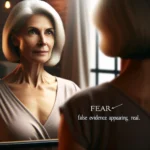What does an eating disorder look like to you?

What does an eating disorder look like to you?
Do you think you can tell a person has an eating disorder just by their appearance? Do you think a person with an eating disorder looks a certain way? Do you think they are either very fat or very thin, depending on the type of eating disorder? Wrong, wrong, wrong.
This Christmas, millions of people around the world will be silently struggling with an eating disorder. The festive season, along other family gathering events, is often a time of great anxiety and fear, for a person with an eating disorder. What is a festive, gloriously happy time for most of us, is an ordeal for someone with an eating disorder. People around us won’t know. They won’t have any idea. Why? Because we don’t look the way people with eating disorders are supposed to look. We don’t fit a stereotype.
Most of us hide behind a mask. I don’t mean the mask we wear to ward off COVID-19, but the invisible mask that hides our panic. We try to be jolly to the world around us, but are shaking within. How can we get through the gauntlet of tables loaded with favourite foods and treats? The worry starts weeks before December 25. If we make a huge effort and eat like those around us, we will avoid remarks like, “Why aren’t you eating today?” “Worried about your weight, are you?” but will be driven to punish ourselves with a strenuous workout later that day, to account for what we have consumed. If we place our usual small, concise amount of food on our plate, we will be subjected to interrogation, like “There’s something wrong with you, if that’s all you are eating”, “Isn’t my cooking good enough for you?”
Wearing a mask is awfully draining and misunderstandings mount
Wearing the invisible mark is incredibly draining, requiring constant vigilance to avoid being found out. It might also require some devious behaviours – like pretending to eat Grandmother’s special seasoning or dessert, and furtively hiding it behind a bush, feeding it to the dog, tipping it into the rubbish bin or, when really desperate, dropping it into one’s deep pocket. This sort of behaviour is incredibly draining. It is of the eating disorder, not us. In addition to fear and anxiety, we now have guilt to deal with as well.
Attending to all this bothersome talk going on inside our head, behind our mask, may cause us to appear withdrawn and aloof. We may be reproached for “not joining in the conversation”, so now we add misunderstanding to our internal load of fear, anxiety and guilt. It goes on and on. We are highly relieved, and exhausted, when the day is done.
If you are experiencing symptoms of an eating disorder, my wish for you this Christmas is that you will reach out for help. Because help is available. You can be free like me to enjoy all the fun (and the food) of Christmas and every other meal throughout the year.
Myths around who is affected by eating disorders account for why experts believe a significant number of people go undiagnosed and don’t get support. They don’t feel like they can get help because their experience feels so unusual.
So what does an eating disorder look like? Listen to this podcast
To help you understand and for friends and family to understand what living with an eating disorder is like, I encourage you to listen to this podcast (below) prepared by Butterfly. You will hear from AJ, an Indigenous man who thought that eating disorders only happened to pretty girls who did ballet, and that what he was experiencing couldn’t be treated. You will hear from me — I’m in my 70s now, and I lived with a debilitating eating disorder for years before I was diagnosed in my 30s. Katie, living in a larger body, has a history of starving herself. Expert researcher Claire Lister and Dr Michelle Blanchard from the National Mental Health Commission and National Stigma Report Card offer insights into why, too often, people with eating disorders ‘hide in plain sight’.
- If you suspect you have a symptom of an eating disorder, take your mask off and reach out for help today. It will be the very best way to celebrate Christmas 2021 and New Year 2022.






Do you have transcripts of podcasts I read info and absorb it better
Thank you